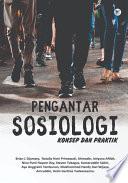Pengantar sosiologi adalah studi tentang masyarakat dan interaksi sosial yang terjadi di dalamnya. Sosiologi sebagai ilmu sosial berfokus pada cara individu, kelompok, dan institusi berinteraksi serta membentuk struktur sosial yang ada di sekitarnya. Dalam pengantar sosiologi, pembahasan utamanya adalah bagaimana masyarakat terbentuk, berkembang, serta berfungsi, serta bagaimana norma, nilai, dan budaya membentuk perilaku sosial. Sosiologi berusaha memahami berbagai fenomena sosial seperti stratifikasi sosial, konflik, perubahan sosial, serta peran lembaga-lembaga sosial seperti keluarga, pendidikan, agama, dan media. Dengan menggunakan pendekatan ilmiah, sosiologi mencoba untuk mengidentifikasi pola-pola sosial yang ada dan menghubungkannya dengan teori-teori yang ada, seperti teori fungsionalisme, konflik, dan interaksionisme simbolik. Melalui pengantar sosiologi, kita belajar bahwa masyarakat bukanlah entitas yang statis, tetapi senantiasa berubah dan dipengaruhi oleh berbagai faktor internal maupun eksternal. Faktor ekonomi, politik, teknologi, serta budaya global yang terus berkembang, turut membentuk dinamika sosial yang ada. Sosiologi membantu kita untuk memahami ketidaksetaraan sosial, diskriminasi, serta masalah sosial lainnya yang ada di masyarakat. Secara keseluruhan, pengantar sosiologi memberikan pemahaman dasar tentang bagaimana masyarakat berfungsi dan berinteraksi, serta menawarkan cara-cara untuk mengatasi berbagai permasalahan sosial yang muncul. Dengan demikian, sosiologi tidak hanya menjadi ilmu pengetahuan, tetapi juga alat untuk menganalisis dan menciptakan perubahan sosial yang lebih baik.
-
ISBN 13 : 6235006446
-
ISBN 10 : 9786235006444
-
Judul : PENGANTAR SOSIOLOGI KONSEP DAN PRAKTIK
-
Pengarang :
Brian L Djumaty,
Natalia Heni Primawati,
Ahmadin,
Istiyana Afifah,
Nina Putri Hayam Dey,
Steven Tubagus,
Kamaruddin Salim,
Ayu Anggraini Tambunan,
Mukhammad Handy Dwi Wijaya,
Amruddin,
Helin Garlinia Yudawisastra,
-
Kategori : Social Science
-
Penerbit : Penerbit Widina
-
Bahasa : id
-
Tahun : 2025
-
Halaman : 240
-
Google Book : https://play.google.com/store/books/details?id=tpRIEQAAQBAJ&source=gbs_api
-
Ketersediaan :
... KOMUNIKASI ( FUNGSIONALISME STRUKTURAL , TEORI KONFLIK , INTERAKSI SIMBOLIK ) MAIN THEORY OF SOCIOLOGY COMMUNICATION ( STRUCTURAL FUNCTIONALISM , CONFLICT THEORY , SYMBOLIC INTERACTION ) . Majalah Seni Ilmiah Populer Komunikasi Massa ...










